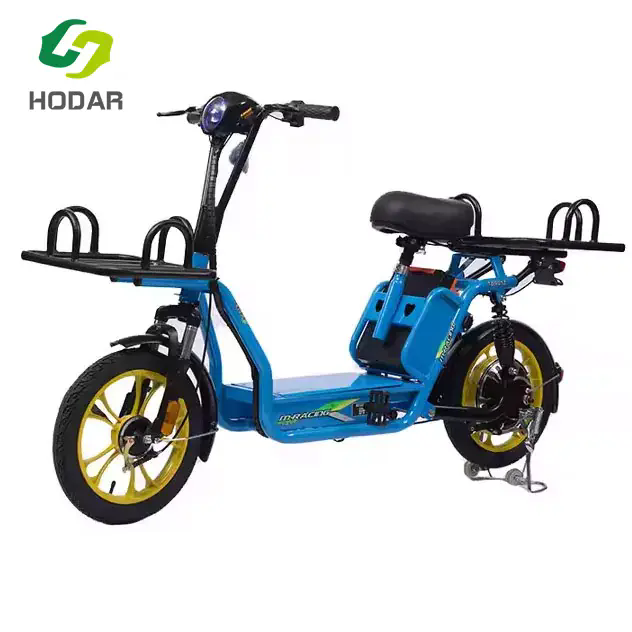How to Choose the Best Electric Bicycle
2025-08-29
As eco-friendly transportation continues to dominate the market, electric bicycles (also known as e-bikes) have become one of the fastest-growing mobility solutions worldwide. They combine the convenience of traditional cycling with the power of electric motors, making commuting, recreation, and long-distance rides easier and more enjoyable. However, with the explosion of e-bike models and technologies available today, choosing the right one can feel overwhelming.
Understanding Electric Bicycles: How They Work and Why They Matter
An electric bicycle is a two-wheeled vehicle powered by both human pedaling and an electric motor. Unlike scooters or motorcycles, e-bikes allow you to pedal normally but provide extra assistance when needed. Depending on the model, the motor can assist your pedaling (pedal-assist) or work independently via a throttle.
How Electric Bicycles Work
At their core, electric bicycles combine three main components:
-
Motor – Provides electric assistance, typically mounted on the front hub, rear hub, or mid-drive (center crank).
-
Battery – Supplies energy to the motor; larger batteries generally deliver longer ranges.
-
Controller – The “brain” of the e-bike, regulating power delivery and allowing you to adjust riding modes.
When you start pedaling, sensors detect your motion and signal the motor to provide support. Depending on the riding mode, you can decide how much electric assistance you want.
Why Electric Bicycles Are Popular
-
Eco-Friendly Mobility – Zero emissions make them sustainable alternatives to cars.
-
Cost-Effective Commuting – Save on fuel, parking, and maintenance.
-
Accessibility – Ideal for riders who need extra assistance on hills or longer routes.
-
Health Benefits – Encourages physical activity while reducing fatigue.
Key Features and Specifications to Consider Before Buying
Choosing the right electric bicycle depends largely on understanding its specifications and how they align with your needs. Below are the most important factors to evaluate:
Motor Types and Power
The motor is the heart of your e-bike, and its placement affects performance:
| Motor Type | Location | Power Range | Best For |
|---|---|---|---|
| Front Hub | Front wheel | 250W – 500W | Urban commuting, flat roads |
| Rear Hub | Rear wheel | 350W – 750W | Balanced rides, light hills |
| Mid-Drive | Crankset center | 500W – 1000W+ | Steep climbs, off-road trails |
Battery Capacity and Range
Battery size is measured in watt-hours (Wh). The larger the Wh rating, the longer the range:
-
250Wh – 400Wh → Up to 30 km per charge (short-distance city riding)
-
400Wh – 600Wh → Up to 60 km per charge (mid-range commuting)
-
600Wh+ → 80 km+ per charge (long-distance rides, touring)
Frame Materials and Design
E-bikes come in various frame types:
-
Aluminum Alloy – Lightweight and affordable, ideal for city rides.
-
Carbon Fiber – Extremely light and strong, perfect for performance cycling.
-
Steel – Heavier but offers better durability and shock absorption.
Braking Systems
Safety should be a top priority. Electric bicycles typically feature:
-
Mechanical Disc Brakes – Affordable and reliable in dry conditions.
-
Hydraulic Disc Brakes – Provide stronger, smoother braking, especially in wet or steep terrains.
Product Parameters Overview
| Feature | Specification |
|---|---|
| Motor Power | 500W Mid-Drive |
| Battery | 48V 15Ah Lithium-ion |
| Top Speed | 28 mph (45 km/h) |
| Range | Up to 75 km per charge |
| Frame Material | Aluminum Alloy |
| Brake System | Hydraulic Disc Brakes |
| Tire Size | 27.5 inches |
| Charging Time | 4–6 hours |
| Display | Full-color LCD with speed, battery, and mode indicators |
How to Choose the Right Electric Bicycle for Your Lifestyle
Selecting the right electric bicycle requires matching your lifestyle and riding preferences with the bike’s features:
Commuters
-
Opt for lightweight city e-bikes with mid-sized batteries.
-
Features like integrated lights and racks are practical for daily use.
Adventurers and Off-Road Riders
-
Choose fat-tire or mountain e-bikes with powerful mid-drive motors.
-
Look for extended battery capacity and suspension systems for rough terrains.
Casual Riders
-
A comfortable step-through frame and moderate 250W motor are ideal.
-
Prioritize ergonomic seats and upright riding posture for leisure cycling.
3.4 Budget vs. Premium Options
-
Entry-Level Models ($800 – $1,200) – Suitable for occasional riders.
-
Mid-Range Models ($1,200 – $2,500) – Perfect balance of quality and performance.
-
Premium Models ($2,500+) – Advanced features, high-capacity batteries, and luxury components.
Maintenance Tips, Safety, and FAQs
Owning an electric bicycle also means knowing how to maintain it properly for long-lasting performance:
Maintenance Checklist
-
Charge Smartly – Avoid overcharging; follow manufacturer guidelines.
-
Check Tire Pressure – Ensures better efficiency and comfort.
-
Inspect Brake Pads – Replace when worn out for optimal safety.
-
Clean and Lubricate Chains – Prevents rust and wear.
Electric Bicycle Safety Tips
-
Always wear a helmet and reflective gear.
-
Use front and rear lights when riding at night.
-
Follow local e-bike speed and lane regulations.
-
Keep a safe distance from pedestrians and vehicles.
Electric Bicycle FAQs
Q1: How long does an electric bicycle battery last?
A high-quality lithium-ion battery typically lasts 3 to 5 years or 500–1,000 full charge cycles, depending on usage and care.
Q2: Can I ride an electric bicycle in the rain?
Yes, most e-bikes are designed to handle light rain and splashes, but avoid submerging the motor or battery in water. Always check the IP rating of the bike for water resistance.
Ride Smarter with Ruifeng Electric Bicycles
As cities evolve and eco-friendly transportation becomes a priority, investing in a reliable electric bicycle is more than a lifestyle choice—it’s a sustainable solution for modern mobility. Whether you’re commuting to work, exploring rugged trails, or enjoying casual weekend rides, selecting the right e-bike ensures comfort, safety, and efficiency.
Ruifeng Electric Bicycles are engineered with cutting-edge technology, powerful mid-drive motors, and long-lasting batteries to deliver an exceptional riding experience. For riders seeking quality, performance, and durability, Ruifeng offers models designed to suit every lifestyle.
Ready to transform your commute or weekend adventure? Contact us today to explore our full range of electric bicycles and find the perfect ride for your needs.



